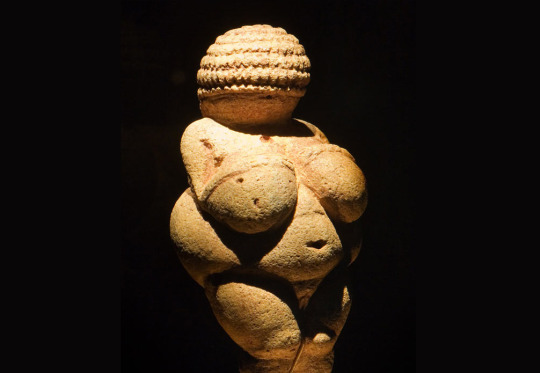#MotherEarthWorship
Text
The Venus of Willendorf

Exploring the Majestic Venus of Willendorf: A Paleolithic Masterpiece
The Venus of Willendorf, considered the most illustrious among the Paleolithic Venuses, is a statuette carved from oolitic limestone and adorned with red ochre paintings, standing at a height of 11 cm. Dated between 24,000 and 22,000 B.C., this iconic work of art is not native to the region where it was discovered but now reigns supreme in the Naturhistorisches Museum in Vienna.
Chronicle of an Extraordinary Discovery
In 1908, archaeologist Josef Szombathy discovered the Venus of Willendorf at an archaeological site near Willendorf in der Wachau, along the left bank of the Danube in Austria. The Paleolithic site underwent careful examination around 1990, allowing a reevaluation of previous estimates regarding the artwork's dating. Stratigraphic analysis indicated that the statuette was created between 25,000 and 26,000 years ago, a significant correction from earlier estimates that erroneously placed it between 10,000 B.C. and 32,000 B.C.
Sculptural Anatomy: Details and Vibrant Colors
The Venus of Willendorf, representing a nude female figure, rests her arms on her breasts. The most distinctive features are the rounded and ample forms, while facial features are deliberately left uncarved. The spherical head is covered with a hairstyle interpreted as a headdress of shells or a coiffure, perhaps reminiscent of the curly and frizzy hair typical of the African population.
The reddish clay surface, combined with the yellowish and porous limestone, creates a play of light and shadow that highlights the roughness of the surface. The underlying shadow emphasizes the abundant shapes of the figure, creating a suggestive chiaroscuro effect.
Symbolic Meaning: Fertility and Mother Earth Worship
The Venus of Willendorf, the precursor of prehistoric Venuses, is steeped in symbolism. These statuettes, usually ranging from 3 to 15 cm, often feature elongated legs and heads, perhaps suggesting the practice of embedding them in fields or among cave rocks, according to the customs of the time.
Accentuated sexual traits, such as monumental breasts, a prominent belly, and ample buttocks, are interpreted as symbols of fertility. The Venus of Willendorf, with its pronounced forms and attention to detail in sculpture, connects to the worship of Mother Earth and her ability to foster prosperity.
In conclusion, this statuette embodies the symbolism of an era where population growth was pivotal in elevating social status, emphasizing the primary importance of births in the construction of a civilization.
#VenusofWillendorf#PaleolithicArt#AncientSculpture#PrehistoricSymbolism#ArchaeologicalDiscovery#HistoricalMasterpiece#MotherEarthWorship#CulturalHeritage#AncientGoddess#SymbolsofFertility#ArtisticExpression#ViennaMuseum#AncientCivilization#HistoricalArtifacts#PrehistoricWisdom#ChiaroscuroEffect#CaveArt#CulturalLegacy#AncientSymbols#ArchaeologicalWonder
0 notes